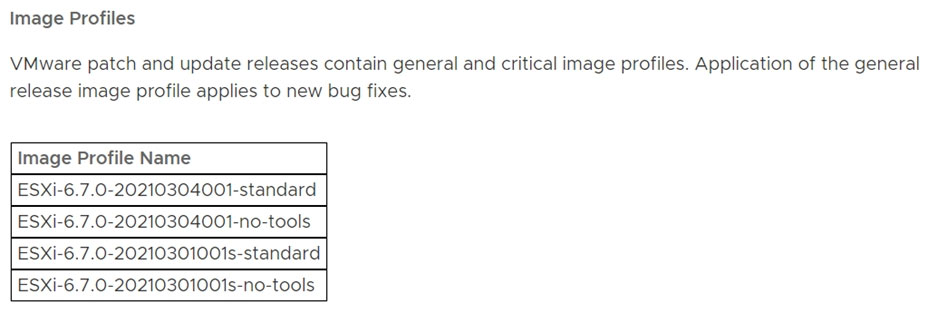A vSAN administrator wants to install a patch on an existing vSAN cluster. The environment runs vSphere 7.0, and the patch contains ESXi 7.0 Update 1c. The vSAN administrator will use vSphere Lifecycle Manager images to add the patch to the proper image and apply it to the vSAN cluster.
Which action should be performed before patching the ESXi hosts in the vSAN cluster?
D
Reference:
https://docs.vmware.com/en/VMware-vSphere/6.7/rn/esxi670-202103001.html
An administrator has successfully deployed a new 3-node vSAN Cluster. Prior to deploying any production workloads on to the new cluster, the administrator must complete a number of Service Validation and Testing (SVT) checks.
The final check requires the administrator to pull out a disk from one of the vSAN hosts.
Which two outcomes will occur within the vSAN cluster following this action? (Choose two.)
CE
Reference:
https://kb.vmware.com/s/article/84248
A host in the cluster experiences a permanent NIC failure, and the replacement part will not arrive until the next morning. The administrator needs to ensure the availability of the production workload at all times.
Which step should be taken by the administrator to meet this goal?
B
Reference:
https://docs.vmware.com/en/VMware-vSphere/6.7/vsan-673-monitoring-troubleshooting-guide.pdf
A vSAN administrator observes that the VMware Skyline Health: Time Synchronization displays one host that is noncompliant.
What is the meaning of this message?
A
Reference:
https://kb.vmware.com/s/article/2149505
A vSAN administrator is tasked to perform an upgrade of a vSAN cluster from 7.0 to 7.0 U2, including firmware and drivers for its hardware. The vSAN administrator already created an image using vSphere Lifecycle Manager (vLCM).
Prior to selecting Start Remediation, which step should be taken to upgrade the complete vSAN cluster as a single task?
B
Reference:
https://www.virtualizationhowto.com/2021/05/use-vsphere-lifecycle-manager-vlcm-for-esxi-7-0-update-2a-upgrade/
An administrator will be performing a rolling upgrade of a vSAN cluster over the weekend. In preparation, the administrator runs the Data Migration Pre-Check.
Which two items are being checked? (Choose two.)
BE
Reference:
https://docs.vmware.com/en/VMware-vSphere/6.7/com.vmware.vsphere.update_manager.doc/GUID-8ECDD0CC-8426-44F9-A283-
301F957D88A2.html
A newly deployed vSAN cluster runs vSAN 7.0, and the vSAN cluster needs an integration with a third-party software solution. The software solution provides full app-level redundancy, and it runs on the vSAN Data Persistence platform.
The administrator configures vSAN Direct Configuration to integrate the third-party storage with vSAN and now needs to configure a storage policy to make sure the vSAN Direct storage is used by the vSAN Data Persistence platform third-party software solution.
Which type of storage policy configuration should the administrator use?
A
Which VM file type resides in the VM home namespace object on a vSAN datastore?
B
Virtual machines deployed on Virtual SAN are made up of a set of objects. For example, a VMDK is an object, a snapshot is an object, VM swap space is an object, and the VM home namespace (where the .vmx file, log files, etc. are stored) is also an object. Each of these objects is comprised of a set of components, determined by capabilities placed in the VM Storage Policy.
A vSAN administrator is looking at adding a new vSAN cluster with hosts that have 512GB memory.
What is the minimum requirement for the node's flash boot device?
A
Reference:
https://thecloudxpert.net/2018/04/05/specialist-vsan-6-x-objective-2-2-describe-vsan-requirements/#:~:text=Flash%20Boot%20Devices,boot%20device
%20must%20be%20%3E%2016GB
All of the virtual machines running on a hybrid vSAN datastore have this storage policy assigned:
Failures to Tolerate (FTT) rule is set to `2 Failures - RAID-1 (Mirroring)`.
The vSAN administrator needs to reduce the amount of vSAN datastore capacity the virtual machines will consume.
Which action should the vSAN administrator take to meet this goal?
A
Reference:
https://virtualization.network/Resources/Whitepapers/36331e5a-aaa8-494c-a025-cb4b95487b90_vmc-aws-manage-data-center.pdf